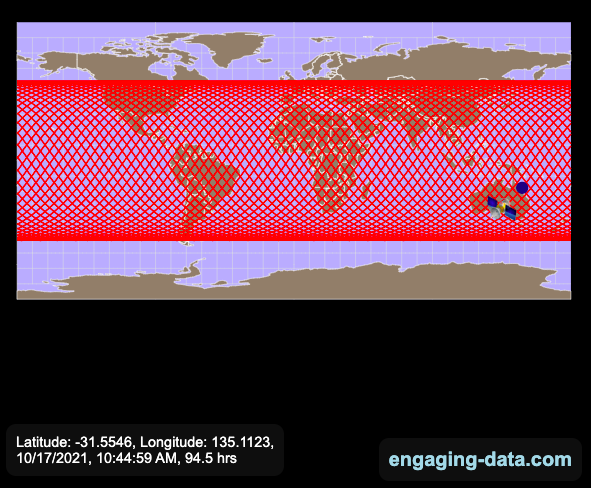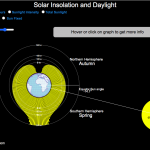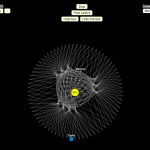Where is the International Space Station currently? And what pattern does it make as it orbits around the Earth?
This visualization shows the current location of the International Space Station (ISS), actually the point above the Earth that the station is closest to. It is approximately 260 miles (420 km) above the Earth’s surface The station began construction in 1998 and had its first long term residents in 2000.
The visualization can also show the animated future orbital path of the ISS using ephemeris calculations, which makes a nice, cool pattern over an approximately 3.9 day cycle, where it starts to repeat. The animation allows you to view the orbital patterns on the globe (orthographic projection) or a mercator or equirectangular projection.
One of the cooler features is to drag and rotate the globe view while the orbital paths are being drawn. You can also adjust the speed of the orbit as well as keep the ISS centered in your view while the globe spins around underneath it. If you select the “rotate earth” checkbox, it becomes apparent that the ISS is in a circular orbit around the earth and that the pattern being made is simply a function of the earth’s rotation underneath the orbit.
This visualization only shows the approximate location of the ISS as there are several confounding factors that are not represented here. The speed of the ISS changes somewhat over time as the station experiences a small amount of atmospheric drag, which slows the station over time. But it still goes over 7000 meters per second or about 17000 miles per hour. As it slows, its orbit decays so it falls closer to earth and it experiences even more atmospheric drag. Occasionally, the station is boosted up to a higher orbit to counteract this decay. Secondly the earth is not a perfect sphere and this also causes the calculations to be only approximately correct.
Some other cool facts about the International Space Station:
- the angle the orbit makes relative to the equator is 51.6 degrees (i.e. this means the highest and lowest latitudes it will reach are 51.6 degrees North and South and doesn’t orbit over the poles
- the circular orbit around the earth makes a sin wave pattern on 2D map projections (shown on the mercator and equirectangular projections
- one orbit takes about 90 minutes. This means there are approximately 16 orbits per day and astronauts aboard the ISS will see 16 sunrises and sunsets
Other cool space-related orbital art can be seen at the inner planet spirographs.
Here are a couple of images showing the final pattern made by the ISS on different map projections.


Sources and Tools:
I used the satellite.js javascript package and the ISS TLE file to calculate the position of the ISS.
The visualization was made using the d3.js open source graphing library and HTML/CSS/Javascript code for the interactivity and UI.

Related Posts
5 Comments »




5 Responses to Visualizing the Orbit of the International Space Station (ISS)
This is one of the coolest things/animations about the ISS that I’ve seen in a while! It fairly matches what I had pictured in my mind with a few minor adjustments. It reminds me of the Star Trek episode “The Tholian Web” as the path encloses the Earth until it is completely surrounded and is trapped forever! Your whole site is filled with really interesting stuff. I’m glad I stumbled across it!
Why doesn’t ISS go over the Poles ??
It would have taken too much energy (= fuel = money) to launch into a polar orbit. Launches make use of the earth’s rotation for some extra free speed (which is why almost everything orbits from west to east, including the ISS). This is why launch sites are as close to the equator as possible in their respective countries, to get the maximum benefit from this. To launch over the poles would require a lot of extra fuel to actually get rid of that extra west-east speed that it got from the earth’s rotation. To get into an exactly polar orbit, you have to get rid of all of that, and you’d have to do the same for every subsequent mission sending up a new crew or supplies. So ISS is in a compromise orbit, to cover most of the planet, but not be too expensive and difficult to launch spacecraft to.
Amazing how this predominantly Russian spacecraft barely orbits over Russia.
looks cool